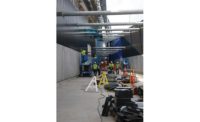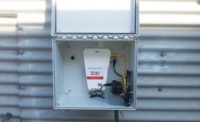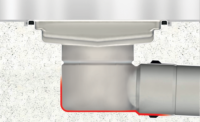Finding a balance in life can be difficult. The same is true for designing a plumbing system. There are situations when creating an efficient plumbing design can influence the safety of the water and vice versa.
While there is no single solution to improve the safety or efficiency in every building, designers need to understand how the system works and who will be using it in order for it to meet both criteria. Obviously, safety is of the upmost importance, but creating efficient plumbing helps preserve our most precious natural resource. There are several ways to assess these points and determine the right path.
The first item to consider is what kind of facility you are designing for, as that will determine the risk level. A nursing home or hospital is going to be more concerned with the safety of the water than a commercial office building or apartment complex, given the occupants’ weakened immune systems. Once you have assessed the risk level of the occupants, the second determination is how to design with that in mind. The safety and efficiency of the design can complement each other if the design engineer understands how the system is being utilized.
Even if the occupants do not have an increased risk, the plumbing design still should balance safety and efficiency. If a dorm or apartment building has low-flow sinks, showers and toilets, the system may not have the capability to flush water through the entire domestic water system because the lines are oversized, thereby creating a situation where water could stagnate. But it goes beyond toilets, sinks and shower lines.
When plumbing systems are designed, there are several things to consider based on the usage of the building. Oversized supply lines lead to water spending more time sitting in the pipes, waiting to be used. This is more noticeable when low-flow fixtures are retrofitted into an existing domestic water system that was designed for higher flow rates. New construction is not immune to ineffective design. Most domestic water systems are designed based on flow tests conducted in the 1800s. Improving efficiency and reducing water consumption is a noble pursuit as long as it doesn’t adversely affect the safety and function of the overall system.
The best offense is a good defense
In most cases, water is clean and safe when it enters a building after being treated by the local utility. It should stay that way. The best solution to unsafe drinking water in a building is prevention. Chlorine residual should be maintained by using the water that enters the building and reducing stagnant branches. Along with reducing water age, maintaining temperatures also can minimize the colonization and amplification of naturally occurring bacteria. This means making sure there are not cross-connects between hot and cold water. The right-sized pipe needs to be chosen based on the fixture demands.
To the same end, installing a filtration system filters out contaminants and minerals – both good and bad. As we learned from an outbreak of Legionnaires’ disease in 2009 originally attributed to the Epic Hotel in downtown Miami, water filters can remove too much chlorine from the water entering the building, which could possibly encourage bacterial growth. One person died and three others contracted Legionnaires’ disease. Further testing revealed that the Epic Hotel was not the source, but its filtration system had been removed and replaced with a different technology.
Some designs benefit from adding filtration or chemical treatment, but there also are simpler ways to improve the safety and efficiency of a domestic water distribution system. Minimizing dead branches and avoiding long, oversized branches reduce the amount of time water sits stagnant in the supply pipes. Each drop to a fixture is a dead branch when that fixture is not used. Fixtures can be plumbed in series so the drop to each individual fixture contains little or no stagnant water when other fixtures are used. Utilizing hot water recirculation systems can keep water out of prime bacteria growth temperature ranges.
Finish the job
A properly engineered system doesn’t end with a good design. The return portion of a hot-water recirculation system, if utilized, also must be properly balanced to ensure design temperatures are maintained throughout the entire hot-water system. The temperature setpoint on the water-heating appliance might suggest any hot water delivered may be outside the ideal growth range for Legionella bacteria, but the actual hot-water temperature in other parts of the system will be lower than the heater setpoint. Water temperatures in remote parts of the hot-water supply or recirculation system could be drastically lower if heat loss is not properly accounted for or return lines are not circulating the proper volume as a result of poor system balancing.
With options such as variable-speed circulators and thermostatic recirculation valves, recirculation systems can be designed with safety and efficiency in mind. Not only can recirculation systems assist in maintaining system design temperatures, they also can reduce water usage by providing hot water to the tap much faster than letting the tap run while waiting for hot water.
There is no single solution, but safety and efficiency need to be balanced in the design. Flushing clean water typically is not seen as an efficient way to maintain water quality, but can be used to drastically reduce stagnation. If flushing is used in a building that has a graywater system, a flushing station with valves and sensors could detect flow, chlorine levels and/or temperature to flush stagnant water and draw fresh chlorinated water to unused potable fixtures without wasting water. Even as this water is flushed out of the potable system, it could be flushed into a graywater system to flush toilets, supply irrigation or makeup water to mechanical systems. Insulating hot water and hot-water recirculation piping can reduce pump and heater run times. Routing cold-water piping through conditioned spaces to keep its temperature low can prolong residual chlorine and minimize bacterial growth.
There is an industry-wide issue in that many potentially dangerous situations may still meet minimum code requirements. Plumbing codes were created to represent the minimum requirements for a safe system, so they must continue to evolve and change to keep up with ever-changing issues that relate to plumbing safety.
The idea that one system fits all is put to the test in every new office building, dorm or hospital that is built or remodeled. And what worked yesterday may not work in today’s complex and evolving systems. Just look at the lead pipes and hollowed-out logs that once transported our water. In every system you design or install, consider the changing use of today’s and tomorrow’s plumbing systems and how you can do your best to balance safety with efficiency.



